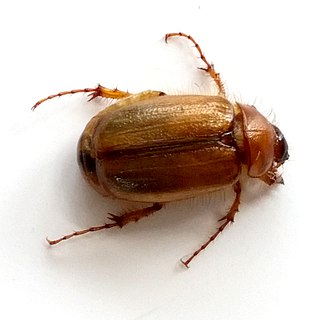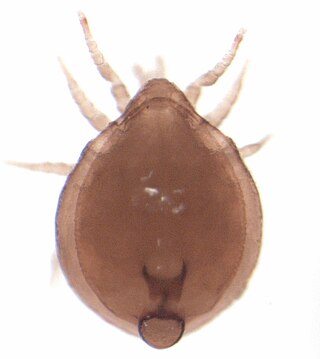Roger Anthony Beaver is a biologist who has worked at University College of North Wales, Chiang Mai University, the University of Zambia and the University of the South Pacific. He has published several important papers on Nepenthes infauna, including "Fauna and food webs of pitcher plants in West Malaysia" (1979), "The communities living in Nepenthes pitcher plants: fauna and food webs" (1983), and "Geographical variation in food web structure in Nepenthes pitcher plants" (1985). The species Cryptoxilos beaveri was named in his honour.

Stigmella hoheriae is a species of moth of the family Nepticulidae. This day flying moth is found in New Zealand in both the North and South Islands. It inhabits native forest. Eggs are laid on the surface of a still growing leaf of a host plant. Larvae feed on Hoheria species such as Hoheria glabrata, Hoheria populnea, Hoheria sexstylosa and Hoheria angustifolia and have been recorded from February to August. The larvae of S. hoheriae are leaf miners. Their mines create blotches on the host plant leaves. S. hoheriae larvae pupate in a silk cocoon on the ground at the base of their food plant. Adult moths have been observed on the wing in February and from July to December. This species is rarely noticed as it is very small and as a result does not tend to attract attention when on the wing.

Ctenarchis is a genus of moths of the family Carposinidae, containing only one species, Ctenarchis cramboides. This species is endemic to New Zealand and is found in the North Island. It has been observed in the Northland, Auckland, as well as in the Tararua regions. Adults have been observed or collected from December to March and in June and July as well as October. As at 2017 the larval host is currently unknown. Adults are attracted to light. It is classified as "At Risk, Naturally Uncommon" by the Department of Conservation.

Dumbletonius unimaculatus, also known as the forest ghost moth, is a species of moth of the family Hepialidae. It is endemic to New Zealand. This species is host to the vegetable caterpillar fungus Ophiocordyceps robertsii.

Costelytra giveni, commonly known as New Zealand grass grub, is a scarab beetle that is endemic to New Zealand and is a prevalent pasture pest.

Hierodoris tygris, also known as the Titirangi Tyger, is a species of moth in the family Oecophoridae. It is endemic to New Zealand and is found in the Auckland and Wellington regions. The larvae of this species is unknown as are the larval host species. Adults have been found on the wing from December to March with one specimen collected in early May. It is a nocturnal species that is attracted to light and has been collected with the use of a mercury vapour lamp. This species is classified as "Not Threatened" by the Department of Conservation.

Oemona hirta, the lemon tree borer, also known as the whistling beetle or the singing beetle, is a longhorn beetle endemic to New Zealand. Its larvae are generalist feeders, boring into the wood of a wide variety of trees, native and introduced. When citrus orchards were first established in New Zealand, this beetle started inflicting serious damage, and so gained the name "lemon tree borer". Four species within the genus Oemona have been identified, suggesting that more species could be found. When disturbed by predators or humans, the adult beetle stridulates creating a "rasp" or "squeak" sound by rubbing its thorax and head together against an area of thin ridges. Māori would eat a liquid called "pia manuka", which was produced by manuka trees when its wood was damaged by the larvae. When Captain Cook first arrived in NZ, his naturalists, Banks and Solander, collected a lemon tree borer in their first collection between 1769 and 1771. This oldest collected specimen can be found in the British Museum. A few years after the first collection, the species would be first described by the Danish naturalist Fabricius in 1775.

Ichneutica peridotea is a moth of the family Noctuidae. This species is endemic to New Zealand. The species is similar in appearance to Ichneutica plena but are more dull olive-green in appearance and the male lacks the patches of orange-brown forewing scales of the male I. plena. As at 2021 I. peridotera has only been collected in the Auckland District although Robert Hoare hypothesises that its range may include the northern districts of the North Island. The lack of information about this species is partially due to the fact it is late winter flying. The life history of this species is unknown as are the hosts of its larvae. Its preferred habitat is forest and the adults are attracted to light.

Mnesarchaea hudsoni is a species of primitive moths in the family Mnesarchaeidae. This species was first described by George William Gibbs in 2019, and is endemic to New Zealand. It is found in the Auckland, Coromandel, Bay of Plenty, Taupo, Gisborne, Hawkes Bay, Wairarapa and Wellington regions. This species inhabits cool, damp parts of native forest or lives alongside waterways and can be found at altitudes ranging from sea-level up to 800 m. Adults of this species are on the wing from February to April. M. hudsoni is very similar in appearance to its near relatives M. fusca and M. fallax but can be distinguished via differences in male genitalia.

Eatoniella globosa is a species of marine gastropod mollusc in the family Eatoniellidae. It was first described by Winston F. Ponder in 1965. It is endemic to the waters of New Zealand.

Pseudoeconesus bistirpis is a species of caddisfly belonging to the family Hydrobiosidae. The species was first described by Keith Arthur John Wise in 1958, and is endemic to New Zealand.

Stephen Ernest Thorpe was an English-born New Zealand entomologist who contributed vast amounts of data and analysis in many contexts, particularly to iNaturalist.

Bocchus thorpei is a species of wasp belonging to the family Dryinidae. The species was first described by Massimo Olmi in 2007, and is known to occur in New Zealand.

Cyparium thorpei is a species of rove beetle belonging to the family Staphylinidae. The species was first described by Ivan Löbl and Richard A. B. Leschen in 2003, and is endemic to New Zealand.

Chorebus thorpei is a species of parasitoid wasp belonging to the family Braconidae. The species was first described by Jocelyn A. Berry in 2007, and is endemic to New Zealand.

Zealantha thorpei is a species of fly belonging to the family Anthomyzidae. First described by Jindřich Roháček in 2007, it is endemic to New Zealand and currently the only known member of Anthomyzidae found in the country.
Kaurimyia is a monotypic genus of fly belonging to the family Apsilocephalidae. The sole species found in this genus is Kaurimyia thorpei. Both the genus and species were first described by Shaun L. Winterton and Michael Edward Irwin in 2008. Kaurimyia thorpei is endemic to New Zealand.
Alloxysta thorpei is a species of parasitoid wasp belonging to the family Figitidae. The species was first described by Mar Ferrer-Suay and Juli Pujade-Villar in 2012, and is found in Australia and New Zealand.

Uropoda thorpei is a species of tortoise mite belonging to the family Uropodidae. The species was first described by Jenő Kontschán in 2012, and is endemic to New Zealand.

Spathius thorpei is a species of parasitoid wasp belonging to the family Braconidae. The species was first described by Sergey A. Belokobylskij and Andrew D. Austin in 2013, and is endemic to New Zealand.


















